#gaelic festival
Text
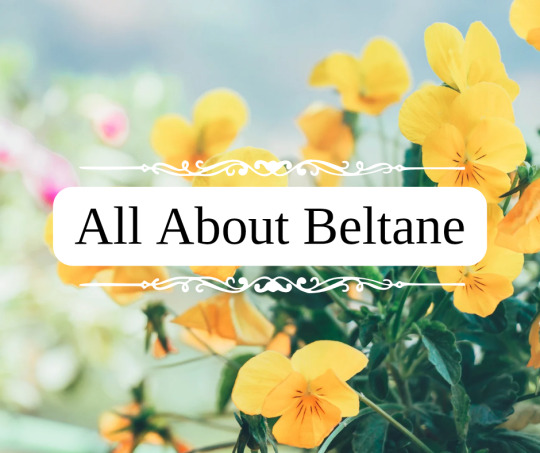
All About Beltane
Beltane, also known as Bealtaine in Irish, is a Gaelic holiday traditionally held on May 1st or the halfway point between the spring equinox and the summer solstice. It is believed to be named after the Celtic sun god Belenus. It was widely observed in Ireland, Scotland, and the Isle Of Man, and is one of the 4 major Celtic fire festivals. It is mentioned in even the earliest Irish literature and marked the beginning of summer and used as the marker to drive cattle into their summer pastures. Although public celebrations have mostly fallen out after the 20th century and many traditions have been mixed with other cultural holidays (such as the Roman holiday May Day), many Celtic Neopagans and Wiccans still celebrate, and many local traditions still continue, causing it to now get a cultural revival.
Traditionally, rituals were held to protect the livestock that moved pastures, along with crops, dairy products, and people, and to encourage growth. It was also important to appease the Aos Sí, or nature spirits/fairies, which were believed to be more active then.
According to early medieval texts in 908, druids would make two bonfires and drive cattle between them to protect them from disease. In the 18th and 19th centuries, bonfires continued to be an important part of the celebrations. Before the bonfires were lit, all hearth fires were put out, and then relit using the fire from the Beltane bonfires after the celebration.
Continuing into the 19th century, cattle were still driven over or between flames, or sometimes around the fires or made to leap over. The people themselves did as well for good luck and protection. Once the fires died down, people would dab themselves with the ashes and sprinkle them over their crops and livestock. Torches from the bonfires would also be brought home and carried around the home or boundaries, and also used to relight the hearth.
Food was also an important part of the Beltane festival, and usually included a feast of lamb, which, historically, was sacrificed. In 1769, it was written that a hot drink, called a caudle, made of eggs, butter, oatmeal, and milk was served, along with tossing a bit on the ground as an offering. A Beltane Bannock, a type of oatmeal cake, was also written to be important and had a few traditions around it.
In one tradition, the Beltane Bannock had nine knobs on it and each person would take the bannock and face the fire, proceeding to break off the knobs of bannock one at a time and tossing them behind their shoulder as an offering to the spirits for protection over their livestock and from predators (one for the cow, one for the sheep, one for the fox, etc). Afterwards, they would drink the caudle.
According to other 18th century writers, there was another Beltane Bannock tradition where the bannock would be cut into slices and one was marked with charcoal. The slices were then thrown into a bonnet and everyone would take one out while blindfolded. According to one writer, whoever pulled the marked bannock slice had to leap through the fire 3 times. According to another, the person would instead be pretend-thrown into the fire and for some time afterward people would talk about the person as if they were dead. This may have always been symbolic, or it may have been a tradition from a time where actual human sacrifice was used. This tradition was also near identical to May Day traditions that occurred in Wales and other parts of Europe, however.
Other traditions including flowers and plants were also observed, especially ones that evoked fire. Documents from the 19th century cite that yellow and white flowers, such as primrose, rowan, hawthorn, gorse, hazel, and marsh marigold was used and placed at doorways and windows. Sometimes they were strewn into garland, and other times they were made into bouquets, made into crosses, or fastened to them. They were also fastened to cows and milking/butter equipment.
Decorating a May Bush or May Bough was also a widespread tradition, and it usually consisted of a small tree or branch (typically hawthorn, rowan, holly, or sycamore) decorated with bright flowers, ribbons, candles, painted shells or egg shells from Easter, and more. In some traditions they also decorated it with gold and silver May Balls, which were hurling balls, that were then either given out to children or gifted to winners of a hurling match. It was also known as the only acceptable time to cut a thorn tree, as they were associated with fairies and may have also been a relic of worshipping tree spirits. It would either be decorated where it grew, or branches hung over windows, doors, roofs, and barns either inside or outside. Traditionally, it was the responsibility of the eldest of the house to decorate it.
The tree was usually left up until May 31st, but in some traditions it would be burned in the festival bonfire after singing and dancing around it. In Dublin and Belfast, May Bushes were brought into town and decorated by the whole neighborhood, with each neighborhood competing for the most beautiful bush. These competitions could also lead to neighborhoods attempting to steal others May Bushes, which eventually led to the May Bush being outlawed in Victorian times.
Appeasing the fairies was also a big part in Beltane celebrations, with many traditions revolving around offerings to the fairies and also warding them off, as there were many fears around them stealing dairy. One protection tradition was to leave 3 black coals under the butter churn. Another was to hang May Boughs on the milk pails. And yet another was to hang cattle tails in the barns. Flowers were also used to decorate the cattle's horns for good luck.
Farmers would also lead a procession around the boundaries of the farm and would "carry with them seeds of grain, implements of husbandry, the first well water, and the herb vervain (or rowan)", stopping at the four cardinal points of direction starting at the east, and performing rituals towards each direction at each stop. These processions were said to bring protection of their farm produce and encourage fertility. Some people also made the sign of the cross using milk on the backside of cattle for good luck.
As for fairy offerings, one tradition was to pour milk or leave food at places associated with the fairies such as "fairy trees". In Ireland, cattle were brought to "fairy forts" where a small amount of their blood was poured into the earth with prayers of the herd's safety. Sometimes, the blood would be left to dry and then be burnt.
Visiting holy wells was also a popular way to celebrate Beltane. Visitors would walk sunwise, moving from east to west, around the well while praying for health. They would then leave offerings of coins or cloth. The first water drawn from the well on Beltane was thought to be especially potent, and would bring good luck to the person who drew it.
Morning dew on Beltane was also thought to bring goodluck and health, and maidens would wash their face with it or roll in it at dawn or before sunrise on Beltane. It was also collected in a jar, left in sunlight, and then filtered. The dew was said to increase sexual attractiveness, maintain youthfulness, protect from sun damage, and ensure skin health during the ensuing year.
Modern day celebrations may vary from these more traditional festival activities, but many choose to incorporate or take inspiration from the traditions at least. Popular traditions still revolve around bonfires, feasts, decorating a May Bush, and focusing on protection and growth.
Beltane Associations
Colors - yellow, white, red, green
Food - lamb, milk and dairy, beef, bannocks, caudle, cakes
Animals - cattle, sheep, other herd animals
Items - primrose, rowan, hawthorn, gorse, hazel, marsh marigold, holly, sycamore, yellow and white flowers, flower garland, greenery, morning dew, dairy products
Crystals - citrine, fire agate, fire opal, carnelian, red and yellow jasper
Other - protection, fertility, good luck, fire, smoke, ash, sun, bonfires, farming
Ways To Celebrate
light a bonfire
jump over or dance around a bonfire
decorate a May Bush or May Bough
craft and hang flower garland
bake Beltane Bannocks
collect morning dew
create some caudle
ward and protect your home or property
leave offerings for the fairies
focus on protection, growth, and luck magic
enjoy time in the sun
have a feast
create a bouquet out of yellow and white flowers
visit a farm or petting zoo
#beltane#beltaine#bealtaine#celtic#gaelic#irish#scottish#pagan#witch#witchy#wicca#may day#magick#magic#magickal#grimoire#tradition#celebrate#bonfire#fire festival#witchcraft#spiritual#witchblr#witch community#paganism#pagan witch#celtic paganism#paganblr#about#dairy
93 notes
·
View notes
Text

Beltane Fire Festival.
#dark aesthetic#heathenism#heathenry#paganism#pagan festival#pagan#pagan aesthetic#beltane#edinburgh#scotland#celtic#celtic paganism#celtic folklore#celts#witchcraft#may queen#pagan rituals#gaelic paganism#neopaganism
44 notes
·
View notes
Text
Celebrating the First Harvest: The History and Differences Between Lughnasadh and Lammas
As the summer sun reaches its zenith and the days begin to slowly wane, two ancient festivals mark the beginning of the harvest season: Lughnasadh and Lammas. Both celebrations, rich in history and tradition, offer a glimpse into the agrarian past of our ancestors and their deep connection to the cycles of nature. While often intertwined and celebrated similarly today, Lughnasadh and Lammas have…
#autumn#Christian#fall#Gaelic#harvest festivals#Lammas#lost traditions#Lughnasadh#medieval#Pagan#Religion#Wheel of the Year
19 notes
·
View notes
Text
Practitioners Busy During Samhain, how do you celebrate?
It’s almost that time of year again and I’m getting ready for Haunt Season. Since my Haunt runs through Samhain and I am both a scare actor and the costumer I don’t get to really celebrate my favorite fire festival.
Any suggestions? What do yall do?
#pagan#sabbats#paganism#pagan holidays#samhain#Fire festivals#pagan festivals#pagan celebrations#death witch#witchblr#folk practitioner#death witchcraft#folk witchcraft#folk magic#queer witch#folk practice#witchcraft#Irish paganism#gaelic paganism#Irish pagan#queer pagan#haunt actor#scare actor
12 notes
·
View notes
Text

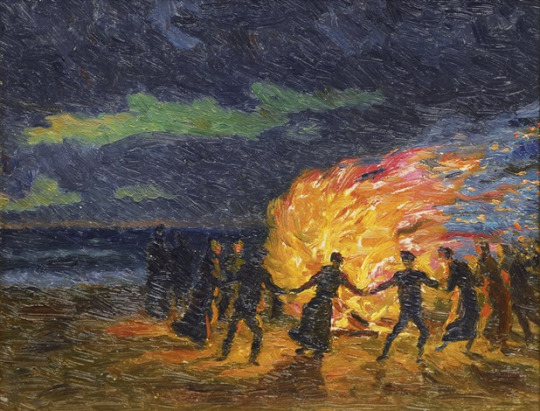

Beltane is an ancient Gaelic fire festival held on the first day of May, a celebration of fertility, light and the beginning of summer. The veil between this world and the Otherworld was thought to be especially thin, and bonfires were lit on sacred hills.
1 Jules Breton (1827-1906)
2 Ernst Wilhelm Eitner (1867-1955)
3 Joseph Tomanek (1889-1974)
#ancient Gaelic fire festival#first day of May#May#celebration of fertility light and the beginning of summer#fertility#light#the beginning of summer#Gaelic#festival#painting
3 notes
·
View notes
Text
bored at work
#there’s a celtic festival happening and i can’t be there#i’m so fucking mad#gaelic storm is gonna be there whyyyyyyyy
2 notes
·
View notes
Text
(Scrounges together all of my autism to convert the holidays in my sims 4 witcher save to in-universe holidays)
#fortunately they’re pretty much just Gaelic festivals#or at least a middle aged polish dudes understanding of them lol
2 notes
·
View notes
Text
Samhain Sona Dhut!
Samhain Sona Dhut – Happy Samhain!
Samhain is a pagan Gaelic festival that marks the transition of summer into winter and is traditionally held on the night of 31st October (and this is because the Celtic day began and ended at sunset), the last day of the harvest, and during November 1st.Samhain was celebrated in Scotland, Ireland, and on the Isle of Man.
Samhain Celebration – image taken from…

View On WordPress
#31st October#Beltaine#Beltane#Bonfire#Celtics#Celts#Druid#Festival#Gaelic#Imbolc#Ireland#Lughnasa#November 1st#pagan#Paganism#Raffaello Palandri#Samhain#Samhain Sona Dhut#Scotland#Summer#tradition#traditional#Winter
3 notes
·
View notes
Link
To learn Scots Gaelic language, common vocabulary is one of the important sections. Common Vocabulary contains common Scots Gaelic words that we can used in daily life. Festival are one part of common words used in day-to-day life conversations. If you are interested to learn Festival vocabulary words in Scots Gaelic, this place will help you to learn all Festival vocabulary words in English to Scots Gaelic language. Festival vocabulary words are used in daily life, so it is important to learn all Festival vocabulary words in English to Scots Gaelic and play Scots Gaelic quiz and also play picture vocabulary, play some games so you get not bored. If you think too hard to learn Scots Gaelic language, then 1000 most common Scots Gaelic words will helps to learn Scots Gaelic language easily, they contain 2-letter words to 13-letter words.
0 notes
Text
Kíla, Paul Frost Brass - Cara Liom (Irish Gaelic)
#festive folk#kíla#paul frost brass#cara liom#irish gaelic#gaeilge#gle#celtic#indoeuropean#europe#ireland#2023#2020s#folk#folksy friday#Spotify
0 notes
Text
August 2024 Witch Guide
New Moon: August 4th
First Quarter: August 12th
Full moon: August 19th
Last Quarter: August 26th
Sabbats: Lughnasadh/Lammas- August 1st
August Sturgeon Moon
Also known as: Barely Moon, Black Cherries Moon, Corn moon, Dispute Moon, Harvest moon, Herb Moon, grain moon, Mountain Shadows Moon, Red moon, Ricing Moon, Weodmonath & Wyrt moon
Element: Fire
Zodiac: Leo & Virgo
Animal spirts: Dryads
Deities: Diana, Ganesha, Hathor, Hecate, Mars, Nemesis, Thot & Vulcan
Animals: Dragon, lion, phoenix & sphinx
Birds: Crane, eagle & falcon
Trees: Alder, cedar & hazel
Herbs: Basil, bay, fennel, orange, rosemary, rue & St.John's wort
Flowers: Angelica, chamomile, marigold & sunflower
Scents: Frankincense & heliotrope
Stones: Carnelian, cats/tiger's eye, emerald, fire agate, garnet, jade, moonstone, peridot, red jasper, red agate, sardonyx, topaz & tourmaline
Colors: Dark green, gold, orange, red & yellow
Energy: Abundance, appreciation, authority, courage, entertainment, finding your voice, friendship, gathering, harvesting energy, health, love, pleasures, power, prophecy, prosperity, vitality & wisdom
The name Sturgeon Moon comes from the giant lake sturgeon of the Great Lakes & Lake Champlain; this native freshwater fish was readily caught during this part of summer & an important food staple for Native Americans who lived in the region. At one time the lake sturgeon was quite abundant in late summer, though they are rarer today.
• August's full moon is the first Supermoon of the year, which means that it will appear bigger & brighter than the full Moons we have seen so far!
Lughnasadh
Known as: Lammas, August Eve & Feast of Bread
Season: Summer
Element: Fire
Symbols: corn, grain dollies & shafts of grain
Colors: Gold, golden yellow, green, light brown, orange, purple, red & yellow
Oils/Incense: Aloe, apple, corn, eucalyptus, safflower, rose & sandalwood
Animals: Cattle (bull & calf)
Birds: Chicken/Rooster
Stones: Aventurine, carnelian, citrine, peridot, sardonyx & yellow diamond
Food: Apples, barely cakes, berries, berry pies, breads, colcannon, cider, corn, grains, honey, lamb, nuts, potatoes, rice, sun-shaped cookies & wild berries
Herbs/Plants: Alfalfa, aloe, blackberry, bramble, corn, cornsilk, corn stalk, crab apple, fenugreek, frankincense, ginseng, goldenseal, gorse, grape, medowsweet, oak leaves, pear, rye, sloe & wheat
Flowers: Clyclamen, heather hollyhock & sunflower
Trees: Acacia, apple, myrtle,oak & rowan
Goddesses: Aine, Alphito, Bracacia, Carmen, Ceres, Damina, Danu, Demeter, Ereshkigal, Freya, Frigga, Gaia, Inanna Ishtar, Kait, Persephone, Sul, Taillte, Tea & Zaramama
Gods: Athar, Bes, Bran, Dagon, Dumuzi, Ebisu, Ghanan, Howtu, Liber, Lono, Lugh, Neper, Odin & Xochipilli
Issues, Intentions & Powers: Accomplishment, agriculture, challenges, darkness, death, endings, release & transformation
Spellwork: Abundance, bounty, fire magick, rituals of thanks & sun magick
Activities:
• Bake fresh bread
• Weave wheat
• Take walks in nature or along bodies of water
• Craft a corn doll
• Learn a new skill
• Watch the sunrise/sunset
• Leave grains and seeds in a place where birds, squirrels and other small animals can appreciate them
• Eat outside with family/friends/coven members
• Donate to your local foodbank
• Prepare a feast with your garden harvest
• Give thanks & offerings to the Earth
• Trade crafts of make deals
• Gather and/or dry herbs to use for the upcoming year
• Celebrate/honor the god Lugh by hosting a competition of games
• Participate in matchmaking or handfasting ceremonies
• Decorate your altar with symbols of the season
• Clean up a space in nature
• Plant saved seeds or save seeds to use in the future
Lughnasadh or Lammas is a Gaelic festival marking the beginning of the harvest season. Historically it was widely observed throughout Ireland, Scotland & the Isle of Man. Traditionally it is held on 1 August, or about halfway between the summer solstice & autumn equinox. In recent centuries some of the celebrations have shifted to the Sunday nearest this date.
Lughnasadh is mentioned in early Irish literature & has pagan origins. The festival is named after Lugh the god of craftsmanship. It was also founded by the god Lugh as a funeral feast & athletic competition/funeral games in memory of his foster-mother Tailtiu. She was said to have died of exhaustion after clearing the plains of Ireland for agriculture.
• Tailtiu may have been an earth goddess who represented the dying vegetation that fed mankind.
• Another tale says that Lugh founded the festival in memory of his two wives, the sisters Nás & Bói.
In the Middle Ages it involved great gatherings that included ceremonies, athletic contests (most notably the Tailteann Games which were extremely dangerous), horse racing, feasting, matchmaking & trading.
• With the coming of Christianity to the Celtic lands, the old festival of Lughnasadh took on Christian symbolism. Loaves of bread were baked from the first of the harvested grain & placed on the church altar on the first Sunday of August. The Christianized name for the feast of Lughnasadh is Lammas which means “loaf mass”.
Some believe this is the time where the God has weakened & is losing his strength as seen in the waning of the day's light. The Goddess is pregnant with the young God who will be born on Yule.
Sources:
Farmersalmanac .com
Llewellyn's Complete Book of Correspondences by Sandra Kines
Wikipedia
A Witch's Book of Correspondences by Viktorija Briggs
Encyclopedia britannica
Llewellyn 2024 magical almanac Practical magic for everyday living
#witch guide#August 2024#Sturgeon moon#wheel of the year#sabbats#lughnasadh#lammas#full moon#witchblr#paganblr#wiccablr#witches of tumblr#tumblr witches#witch community#witchcore#witchcraft#traditional witchcraft#witch tips#beginner witch#baby witch#August Witch Guide#GreenWitchcrafts#moon magic#grimoire#book of shadows#spellbook#spellwork#witches#witch#supermoon
296 notes
·
View notes
Text
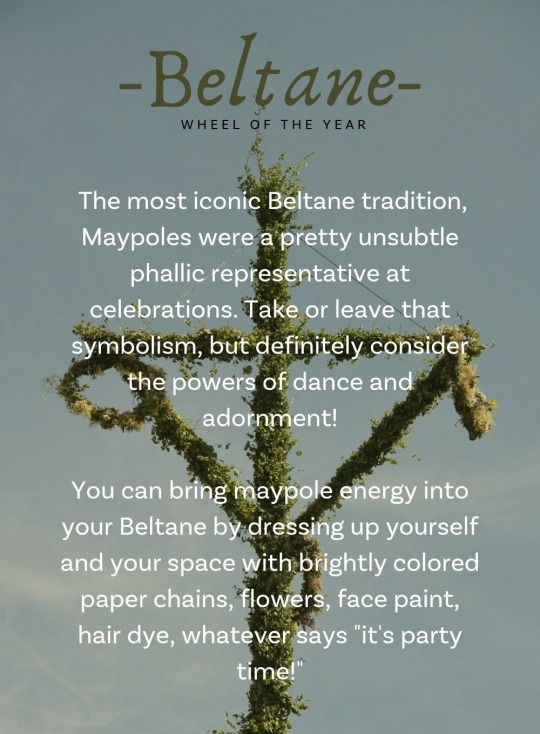
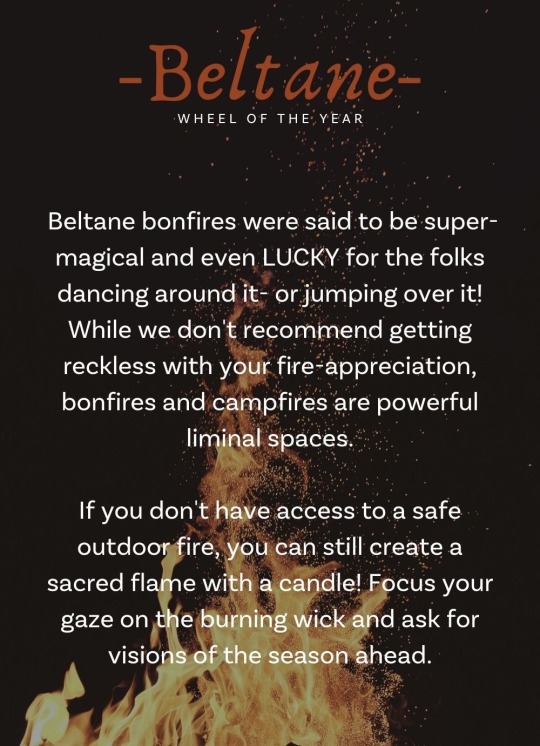
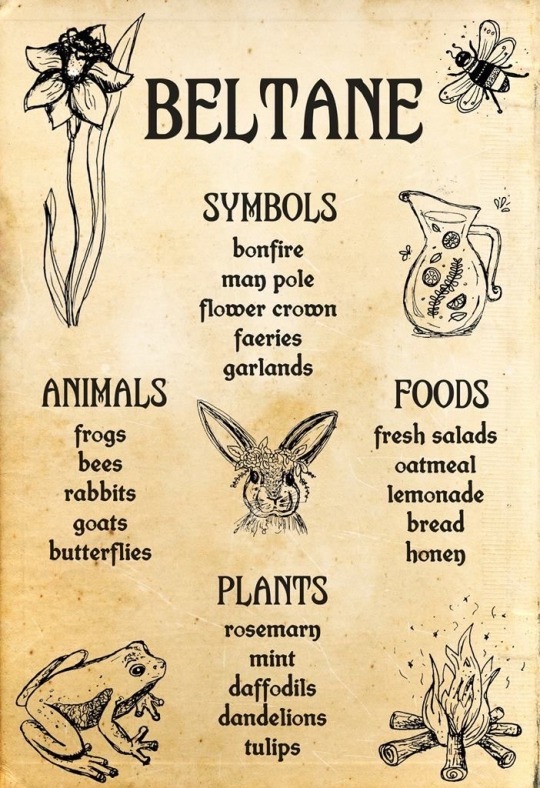
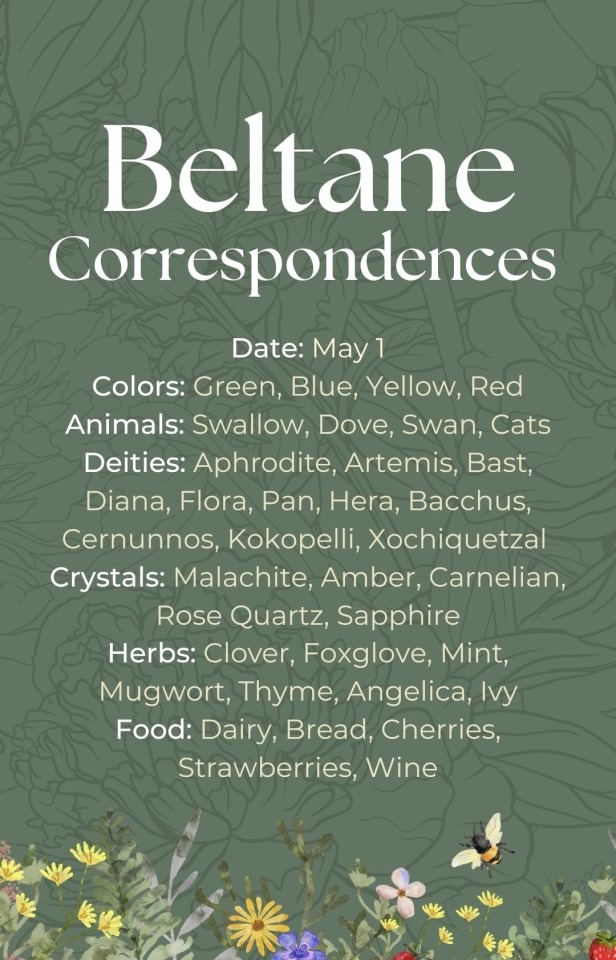
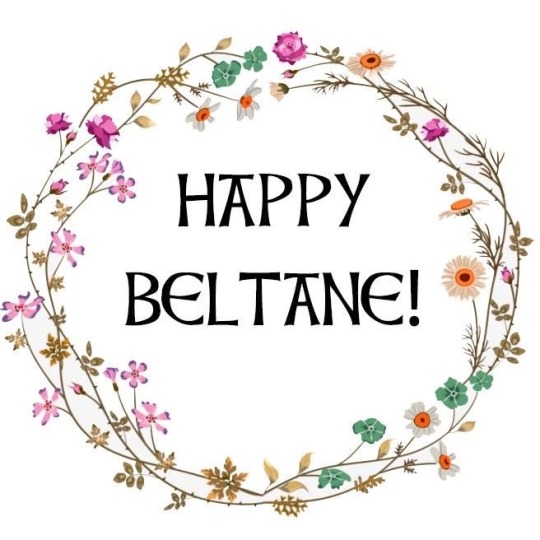
Happy Beltane Witches 😍
✨✨✨✨✨✨✨✨✨✨✨✨✨✨✨✨✨✨
Beltane is a Gaelic festival traditionally celebrated on May 1st.
It marks the beginning of summer and is associated with fertility, fire, and new beginnings.
It's a time to celebrate growth, abundance, and the coming together of communities.
Rituals often include lighting bonfires, dancing around maypoles, and feasting.
It's also considered a time for rituals to encourage fertility in crops, livestock, and people.
✨✨✨✨✨✨✨✨✨✨✨✨✨✨✨✨✨✨
#witchcraft#beltane#witchblr#witches#witchy#dark academia#witch aesthetic#witch#witch community#witchcore#green witch#celebrate#witch coven#Wicca#coven#witch familiar#cats familiar#familiar#maypole#spring#summer#whimsgoth style#whimsigothic#whimsicore#wandering witch#sea witch#easy witchcraft#witchy woman#witchy vibes#eclectic witch
200 notes
·
View notes
Text

Here's Blaze! Her name is is Iris Flare, I started giving them just generalised names in English as I started incorporating more than Scottish folklore into these guys so it didn't make sense to have them all named in Gaelic, the Seasons travel constantly all over the world as they come and go with their seasons so I thought I'd be fun to assign different cultures to each of them!
Some more extensive lore under the cut!
Summer is the second most targeted Seasonal Spirit, but unlike Winter who is largely hated, Summer is regarded as a loved season and those challenging her often want to overthrow her place with malicious reasons, she has no gripe about fighting back but can often leave damage in her wake due to the nature of her flames. She does not see as much war as Winter but she fights just as fiercely. Summer is often compared to Winter but is adamant she does not agree with the ill-manner most refer to Winter with. They've never met but she is not disillusioned by the endless praise she receives against criticism against him. She firmly believes that all seasons are just as equal and should not be given favour over another. She hears about Winter mostly from the birds who migrate between their seasons, and she knows that if Winter was so bad then no bird would make the journey there willingly to avoid her own.
In contrast she is close to the other two seasons Spring and Autumn. She is the second youngest of the four, the order being Winter, Spring, Summer then Autumn. Her and Autumn are particularly close as she helped guide him through his first season when he was largely unprepared for it. Her and the other seasons took up the mantle willingly with an expectation on what their duty was. Iris used to be a mortal Royal who stepped up to inherit the responsibility when a rival kingdom set out to slay the previous Season, her family were historically friends of the Fae so she was asked for specifically and knew what she was getting into and did - and still does - take the responsibility very seriously. She doesn't often engage in festivities without request, but enjoys talking with every being of life regardless of status within a court (or outside one even).
Her flames are an indicator of her emotional state, they sometimes change colour and the temperature can range, so mostly she tries to keep calm and dim her flames especially around dry times in the season, her Sari is woven to be flame-resistant and prevents any accidental burns so she doesn't often take it off. Her jewellery are a close replica of the ones she wore as a mortal, it has been eons since so she pays tribute to the memories even as they grow faint. Ironically she mostly enjoys the rain when she can let her flames burn as bright as she likes. She enjoys flying as high as she can, where the only thing that can catch fire is herself, and the chill allows her to push her fire beyond what she could do safely on the ground.
280 notes
·
View notes
Text
DON'T CALL ME MABON
WHY MABON IS AN INAPPROPRIATE NAME FOR THE AUTUMN EQUINOX
by Anna Franklin
The name ‘Mabon’ as a term for the neopagan festival of the autumn equinox (along with the Saxon term ‘Litha’ for the summer solstice) was introduced in 1973 by the American witch and writer Aiden Kelly (b. 1940). His blog for 21st September 2012 explains:
“Back in 1973, I was putting together a “Pagan-Craft” calendar—the first of its kind, as far as I know—listing the holidays, astrological aspects, and other stuff of interest to Pagans. It offended my aesthetic sensibilities that there seemed to be no Pagan names for the summer solstice or the fall equinox equivalent to Ostara or Beltane—so I decided to supply them… I began wondering if there had been a myth similar to that of Kore in a Celtic culture. There was nothing very similar in the Gaelic literature, but there was in the Welsh, in the Mabinogion collection, the story of Mabon ap Modron (which translates as “Son of the Mother,” just as Kore simply meant “girl”), whom Gwydion rescues from the underworld, much as Theseus rescued Helen. That’s why I picked “Mabon” as a name for the holiday…” bd
Curiously, his own tradition, the New Reformed Orthodox Order of the Golden Dawn, did not follow him in this and instead called the autumn equinox ‘Rites of Eleusis’. However, the term took off and was used in many American books, and by extension, the readers of those books in the UK and elsewhere.
The association of the god Mabon with the festival is certainly not an ancient or traditional despite the claims in various books and websites where you might read ‘the Celts celebrated the god Mabon on this date’.
In order to see why the name of Mabon for the autumn equinox is an inappropriate one we need to examine the tales of Mabon.
The Celtic God Maponius
There is certainly a Celtic god whose title was Latinized as Maponus, which is not an actual name but means something like ‘divine son’. He is known from a number of inscriptions in northern Britain and Gaul in which he is addressed as ‘Apollo Maponus’ identifying him with the Graeco-Roman sun-god Apollo. Like Apollo, all the evidence suggests that he was a god of the sun, music and hunting – significantly, he was not a god of the harvest or of the corn.
It is not known whether he was widely worshipped before the coming of the Romans, but with them his cult spread along Hadrian’s Wall amongst the Roman soldiers stationed there. Several stone heads found at the Wall are identified as representing Maponus.
He was also known in Gaul where he was invoked with a Latin inscription at Bourbonne-les-Bains, and on a lead cursing tablet discovered at Chamalières, Puy-de-Dôme where he is invoked along with Lugus (Lugh) to quicken underworld spirits to right a wrong.
It is possible that there are some place names associated with him, such as Ruabon in Denbighshire, which may or may not be a corruption of Rhiw Fabon, meaning ‘Hillside of Mabon’. be During the seventh century an unknown monk at the Monastery at Ravenna in Italy compiled what came to be called The Ravenna Cosmography, which was a list of all the towns and road-stations throughout the Roman Empire. It lists a Locus Maponi (‘place of Maponus’) which has been tentatively identified with the Lochmaben stone site.
It is possible that Mabon’s Irish equivalent is the god Aengus, also known as the Mac Óg (‘young son’).
Literary Sources
A character called Mabon is found as a minor character in the Mabinogion, a collection of eleven – sometimes twelve – Welsh prose tales from the Middle Ages. He is called Mabon ap Modron, meaning ‘son of the mother’, which has led to speculation that his mother Modron (‘mother’) may be cognate with the Gaulish mother goddess Matrona. There are no inscriptions dedicated to her from ancient times, so this cannot be verified. Whether or not the Mabinogion tale of the hero Mabon stems from a thousand year old story of the god Maponus is uncertain, but since the stories contain the names of other known Celtic gods (transliterated into heroes) it is certainly possible.
The Mabinogion is a collection of medieval Welsh stories which would have been recorded by Christian monks. They don’t seem to have been very widely known until they were translated into English in 1849 by Lady Charlotte Guest, who invented the title Mabinogion since each of the four branches ends with the words “so ends this Branch of the Mabinogi”. In Welsh, mab means ‘son’ or ‘boy’ or ‘youth’, so she concluded that mabinogi meant ‘a story for children’ and (erroneously) that mabinogion was its plural. Another possibility is that it comes from the proposed Welsh mabinog meaning something like ‘bardic student’.
The stories now included in the Mabinogion are found in two manuscripts, the older White Book of Rhydderch (c.1300–1325) and the later Red Book of Hergest (c.1375–1425) and Lady Charlotte Guest used only the latter as her source, though later translations have drawn on both books.
The first four tales, called The Four Branches of the Mabinogi, are divided into Pwyll, Branwen, Manawydan and Math and each of these includes the character Pryderi. The Mabinogion scholar W.G.Gruffydd suggested that the four branches of the collection represent the birth, exploits, imprisonment and death of Pryderi.
Mabon is mentioned in the Mabinogion story of The Dream of Rhonabwy in which he is described as one of the King’s chief advisors and fights alongside him at the Battle of Badon. His biggest role comes in the story of Culhwch and Olwen (originally from White Book of Rhydderch). In it is the only known reference to Olwen, and Mabon is still a very minor character in the story. One task of the heroes is to search for Mabon ap Modron, who was imprisoned in a watery Gloucester dungeon. Arthur’s cousin Mabon had been taken from his mother Modron when he was only three nights old, and no one knew whether he was alive or dead. After asking the oldest animals, they were finally directed to the oldest creature of all: the great Salmon of Llyn Llyw. The salmon recalled hearing of Mabon, and told them that as he swam daily by the wall of Caer Loyw, he heard a constant lamentation. The salmon took Cei and Gwrhyr upon his back to the castle, and they heard Mabon’s cries bewailing his fate. Mabon could not be ransomed, so seeing that force was the only answer, the knights fetched Arthur and his war band to attack the castle. Riding on the salmon’s back, Cai broke through the wall and collected Mabon, both fleeing on the back of the salmon.
Let us suppose for a moment that the god Maponus and the literary hero Mabon are one and the same. We must remember that all the evidence points to Maponus being the young sun god, his youth meaning that he would represent the morning sun or the sun newly reborn after the winter solstice. His theft from his mother after three days would make sense in this light – the three days being the three days the sun stands still at the winter solstice. The imprisonment of the young god underground equates to the sun in the underworld before he is ‘released’ to begin his reign as the new sun. In Culhwch and Olwen, Mabon is said to be imprisoned inside a tower in Gloucester, from which he is freed by Cei and Bedwyr. The ‘missing sun’ or ‘imprisoned sun’ is a premise found in the solar myths of many cultures to explain the night or the shorter days of winter, especially those around the three days of the winter solstice. Such tales often include themes of captivity or the theft of the sun (i.e. the god or object that represents it) and its rescue by a band of heroes, such as Jason and the Argonauts rescuing the Golden Fleece (the sun) from the dragon or the Lithuanian sun goddess Saule, was held in a tower by powerful king, rescued by the zodiac using a giant sledgehammer, or the Japanese sun goddess Amaterasu hiding in a cave.
An earlier source that mentions Mabon is the tenth century poem Pa Gur, in which Arthur recounts the great deeds of his knights in order to gain entrance to a fortress guarded by Glewlwyd Gafaelfawr. In this, Arthur describes Mabon fab Madron as one of his men and says that Mabon is a servant of Uther Pendragon. A second Mabon is mentioned, Mabon fab Mellt (‘Mabon Son of Lightning’) and this is interesting, since the sky/storm god is often the father of the sun god in myth, as Zeus is the father of Apollo.
Mabon defeats the monstrous boar, and in myth the boar is often a symbol of winter and the underworld, just as the sun after the winter solstice defeats winter. Mabon then is the divine sun-child born at the winter solstice and this is his festival – he is not the aged god of the harvest or the seed in the ground as Kore is in Greek myth. As Sorita d’Este says:
“Honour Mabon as a Wizard, a Merlin type figure, as the oldest of men and beasts, honour him as the Son of the Mother, and a hero – don’t take that away from him by ignorantly using his name as if it is a different word for Autumn Equinox. If you really believe that the Old Gods of these lands still live, that they should be honoured and respected, then do that. Don’t join the generations who tried to belittle the Gods in an effort to diminish their power.”[1]
© Anna Franklin, The Autumn Equinox, History, Lore and Celebration, Lear Books, 2012
#thevirginwitch#witchcraft#witch#witchblr#witchy#witches of tumblr#pagan#baby witch#beginner witch#wheel of the year#mabon#fall equinox#autumnal equinox#autumn equinox
65 notes
·
View notes
Photo
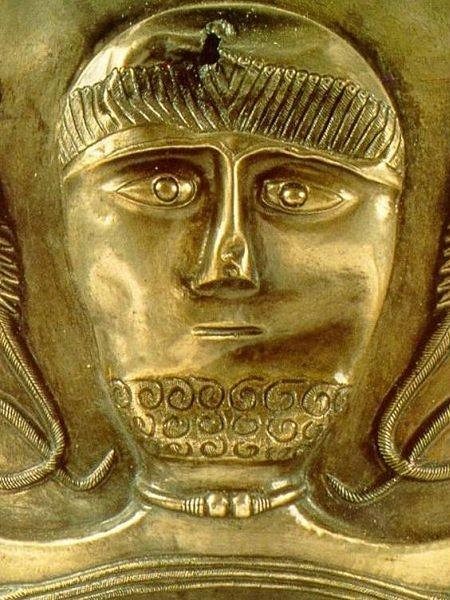
The Dagda
The Dagda (also Daghda, Daghdha, Dagdae, or Dagda Mór), usually written with the definite article, is one of the most important gods in Irish-Celtic mythology. He appears as a multi-talented warrior-leader of the Tuatha Dé Dannan, invaders of ancient Ireland who win a battle against the resident Fir Bolg. Another battle follows, this time against the seafaring Fomorians, and again the Tuatha Dé Dannan are victorious. It is the Fomorians who set the Dagda his famous challenge of eating a huge amount of porridge from his own magical cauldron. With his mighty club, inexhaustible cauldron, and great talent playing the harp, the Dagda was a universal god in Irish mythology considered to dwell in many places, including at Newgrange. As his warrior character, the Dagda is killed by Caitlín, queen of the Fomorians.
Names
Dagda means the 'good god' and the name often appears with a variety of spellings. The sense of 'good' in this context is 'many-skilled' as the Dagda was considered a master craftsman, warrior, magician and ruler. The god may also be referred to as Eochaid Ollathair, meaning 'father of all' or 'mighty father', Ruad Rofhessa, meaning 'lord of great knowledge', or Deirgderc, 'red eye' (referring to the sun). Although recognised by scholars as an important early Irish-Celtic deity, his precise significance is not known. Some have identified him as a sky god and ancestor deity similar to Cronus in Greek mythology. In any case, it is thought that these ancient Celtic gods were not specifically a focus of religious rituals in their particular honour. In contrast, his character as a divine warrior is better represented and seen in the mythological tales of early Irish history which were first written down from around the 8th century CE onwards.
We do know that in the religion of the ancient Celts the Dagda was a prominent figure in the festival of Samhain (aka Samain) which, on 1 November and including the evening of the 31st, celebrated the end of the old year and the beginning of the new. This was also a time when the spirits of the Otherworld could be best contacted. If the Dagda and the war goddess the Mórrigan, sometimes known as the 'queen of demons', came together at this time, then their sexual union would guarantee the fertility and prosperity of the tribe and its harvests and livestock in the coming year. The Dagda was also thought to have had intercourse with two other goddesses during Samhain, these are Boand (aka Boann, goddess of the Boyne River) and Indech (daughter of a renowned warrior of the same name). For this reason, in Gaelic oral traditions in Ireland and Scotland, Samhain was considered the most auspicious time to become pregnant.
Continue reading...
78 notes
·
View notes
